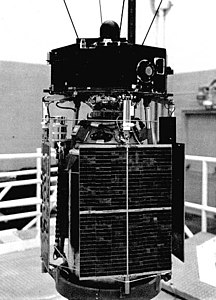Explorer 41
| Explorer 41 | |
|---|---|

|
|
| Country: |
|
| Operator: | NASA |
| COSPAR-ID : | 1969-053A |
| Mission dates | |
| Dimensions: | 175.0 kg |
| Begin: | June 21, 1969, 08:53 UTC |
| Starting place: | Vandenberg SLC-2W |
| Launcher: | Thor-Delta-E1 482 / D69 |
| Status: | out of order since December 23, 1972 |
| Orbit data | |
| Rotation time : | 4,840.9 min |
| Orbit inclination : | 85.1 ° |
| Apogee height : | 172,912 km |
| Perigee height : | 3,920 km |
| Eccentricity : | 0.89132 |
Explorer 41 (also IMP-G ) was a satellite of the US space agency NASA as part of the Explorer program . It was part of the Interplanetary Monitor Platform (IMP) program, which was supposed to collect information about solar flares , among other things . In addition, studies of the terrestrial and galactic magnetic fields, the solar corpuscular radiation , the solar and the cosmic radiation should be carried out. In addition, the Apollo missions should be warned of solar flares. For this purpose, the satellite was placed in a strongly eccentric orbit that reached into the area between the earth and the moon (cislunar space). The satellite was spin stabilized. After an almost smooth mission with only a few interruptions in data transmission, it was decommissioned shortly after Apollo 17 landed on December 23, 1972.
swell
- Herbert Pfaffe, Peter Stache: spacecraft. A type book , 1972
Individual evidence
- ↑ Explorer 41 (IMP-G) in the NSSDCA Master Catalog , accessed on November 26, 2014 (English).
